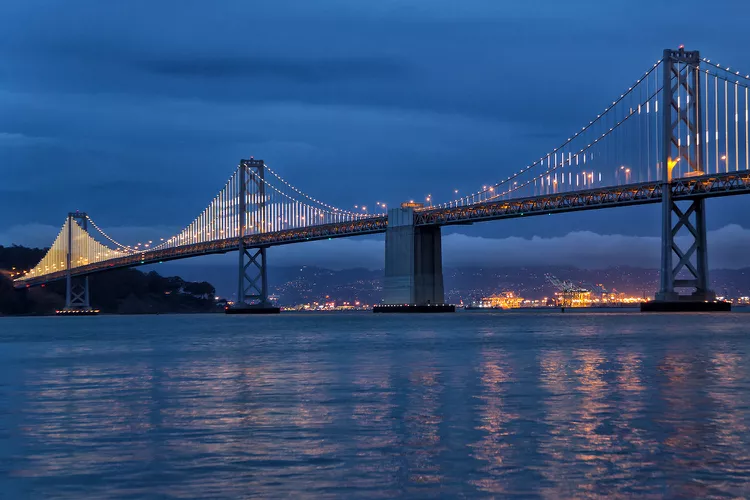Summary
Seeing the Bay Lights
Going to view the lights is one of the most captivating experiences in San Francisco at night. Here are some prime locations to enjoy this mesmerizing display:
- Along The Embarcadero between the Ferry Building and the bridge, particularly from the end of Pier 13.
- The end of Pier 39 offers a different perspective, though it is farther away.
- For a panoramic view, head to Coit Tower on Telegraph Hill.
- Treasure Island’s west side provides a stunning view of the entire span and the San Francisco skyline.
- Experience the lights from above at the Top of the Mark restaurant and bar at the Mark Hopkins Intercontinental Hotel.
- From the Marin Headlands, enjoy a breathtaking view of both the Golden Gate Bridge and the Bay Bridge at the Hawk Hill lookout point.
- Twin Peaks offers another vantage point, allowing you to appreciate the Bay Lights along with a comprehensive view of the city.
How the Bay Lights Got Started
Before 2014, the San Francisco Bay Bridge often played second fiddle to its iconic neighbor, the Golden Gate Bridge. This changed dramatically in celebration of the Bay Bridge’s 75th anniversary. Artist Leo Villareal transformed the once-unremarkable span into the world’s largest LED light sculpture, installing 1.8 miles of energy-efficient white lights along its vertical cables. This monumental project was swathed in creativity and ranks eight times larger than the lighting for the Eiffel Tower’s 100th anniversary.
Initially designed to last for just two years, the installation captivate audiences from its inception. According to Illuminate the Arts, the response was overwhelmingly positive, prompting the organization to raise $4 million to preserve the display as a permanent fixture. Consequently, the Bay Lights became a permanent part of San Francisco’s vibrant scene as of January 2016.
Seeing the San Francisco Bay Bridge
While the Bay Lights are a major attraction, the bridge itself deserves exploration. If you prefer an active approach, consider biking or walking the 4.4-mile trail that runs along the south side from Oakland. The Vista Point on Yerba Buena Island features benches perfect for taking breaks while admiring the view, making it a great spot to relax.
Alternatively, utilize rideshare services like Uber or Lyft to reach the Vista Point, using 9 Hillcrest Rd, San Francisco, CA as your destination.
Driving to the Bay Bridge
When crossing the Bay Bridge, understand that the view differs based on your direction. Eastbound lanes on the western section are situated on the lower deck, limiting visibility, while the westbound perspective offers splendid views. There is no toll for driving from San Francisco to Treasure Island, but if you are coming from Oakland, be prepared to pay a toll.
To reach the Bay Bridge from Treasure Island, take eastbound Interstate 80 towards Oakland, exit for Treasure Island, and park in the waterfront area for exceptional views of the San Francisco Bay Bridge and the skyline.
For a fantastic view of the new span, turn right on California Ave after passing the old guard gate and proceed to the east side of Treasure Island.
What You Need to Know About the Bay Bridge
The structure of the San Francisco Bay Bridge consists of two separate spans connected by a tunnel burrowed through Yerba Buena Island. On the San Francisco side, it features two complete suspension bridges, back-to-back, with a central anchorage.
Here are some key facts about the San Francisco Bay Bridge:
- Both sections combine to a total length of 23,000 feet (4.5 miles).
- The entirety of the Bay Bridge measures 43,500 feet (8.5 miles) from one approach to the other.
- The west span extends 2,310 feet (with a total length of 9,260 feet), soaring 220 feet over the water. Each cable comprises 0.195-inch diameter wires, with 17,464 wires per cable totaling 28.75 inches in diameter.
- The east span holds the title of the world’s longest self-anchored suspension bridge.
- The tunnel on Yerba Buena linking the two spans is 76 feet wide and 58 feet tall.
- The deepest pier plunges 242 feet below the surface and contains more concrete than the Empire State Building.
- Daily, over a quarter-million vehicles cross the bridge.
- The construction in 1933 accounted for more than 6% of total U.S. steel output.
For further information, consider visiting the Bay Bridge website.
San Francisco Bay Bridge History
In 1928, the landscape of the San Francisco Bay was notably different. The landmark bridges we recognize today were nonexistent, and 46 million people traversed the bay exclusively by ferry, leading the waterways to become overcrowded and underscoring the urgent need for alternative modes of transportation.
By 1929, the State of California initiated plans for new infrastructure. After thorough studies and just over three years of construction, the San Francisco Bay Bridge officially opened to traffic on November 12, 1936. The project’s total cost, which included an electric railroad now abandoned, amounted to $79.5 million.
At first, the upper deck accommodated three lanes in each direction, with trucks and the inter-urban railway positioned on the lower level. By the time the bridge opened, it had already reached traffic levels anticipated for 1950. The railway was dismantled in 1959, converting the lower deck for five lanes of eastbound traffic, while the upper deck transitioned to five lanes heading west.
Lastly, the bridge’s towers withstood the 1989 Loma Prieta Earthquake (7.1 on the Richter scale) without significant damage. However, the decks experienced extensive problems, with bolts shearing and part of the upper deck collapsing onto the lower structure.





